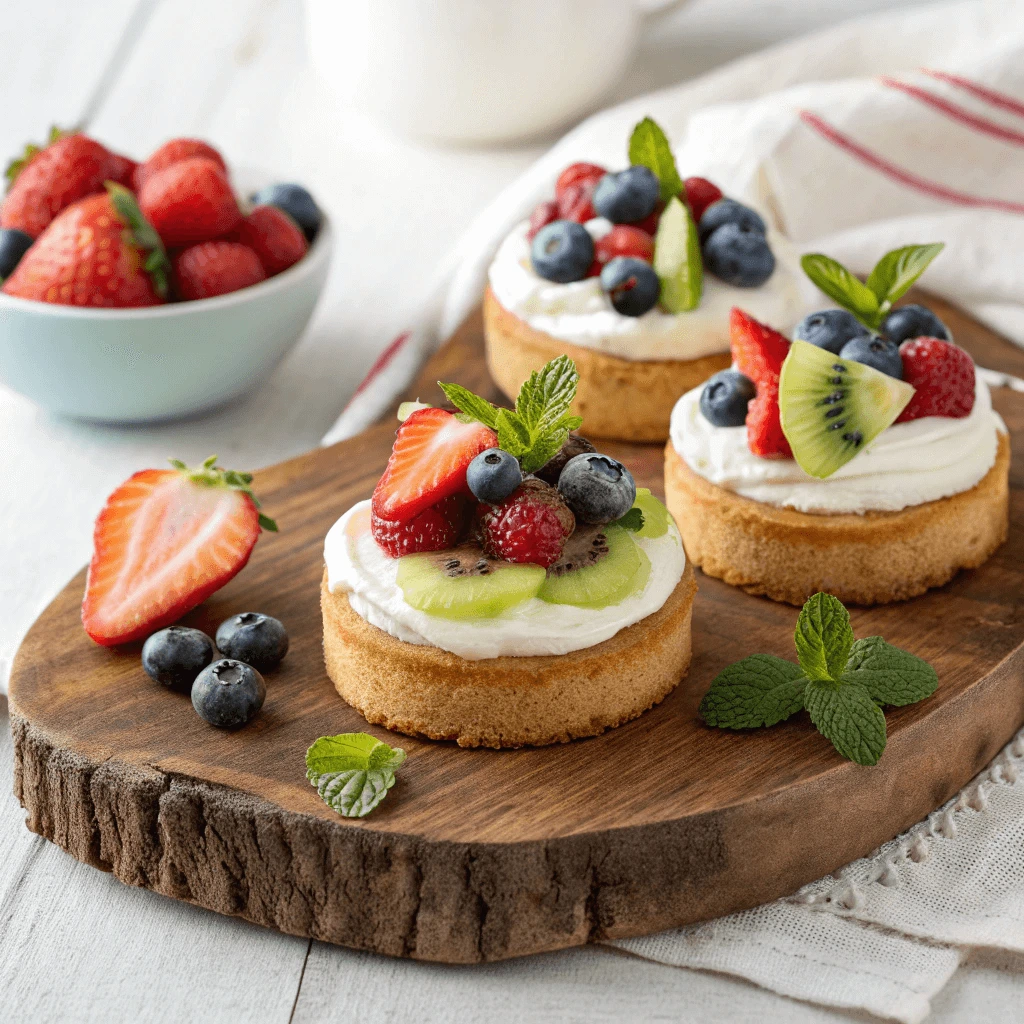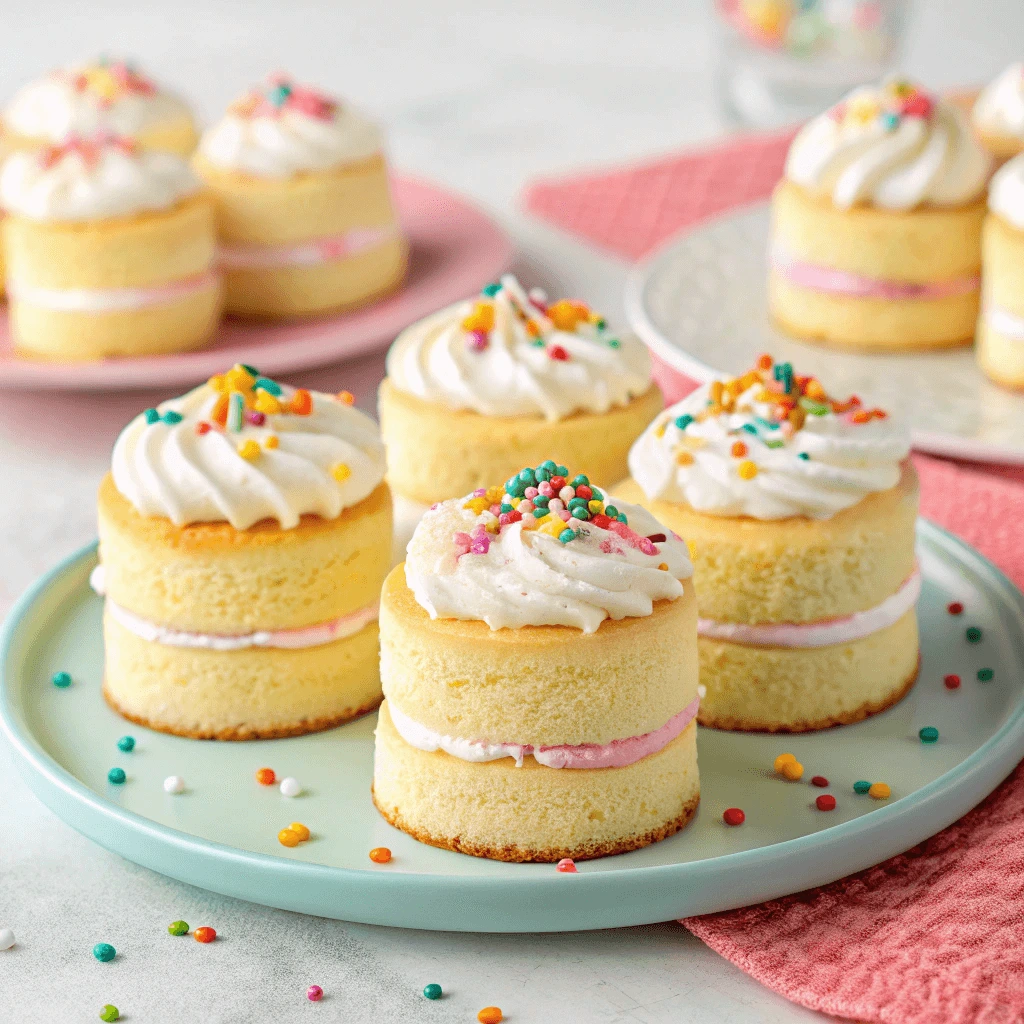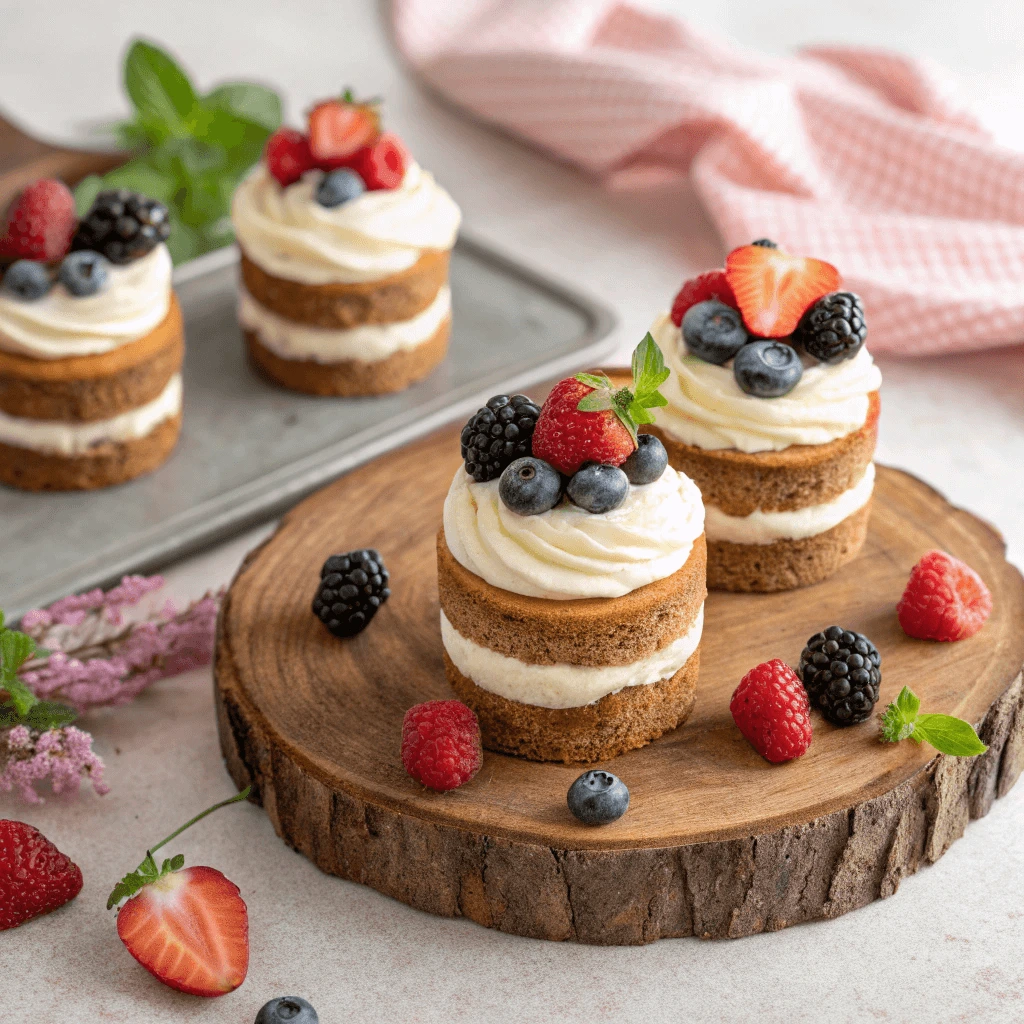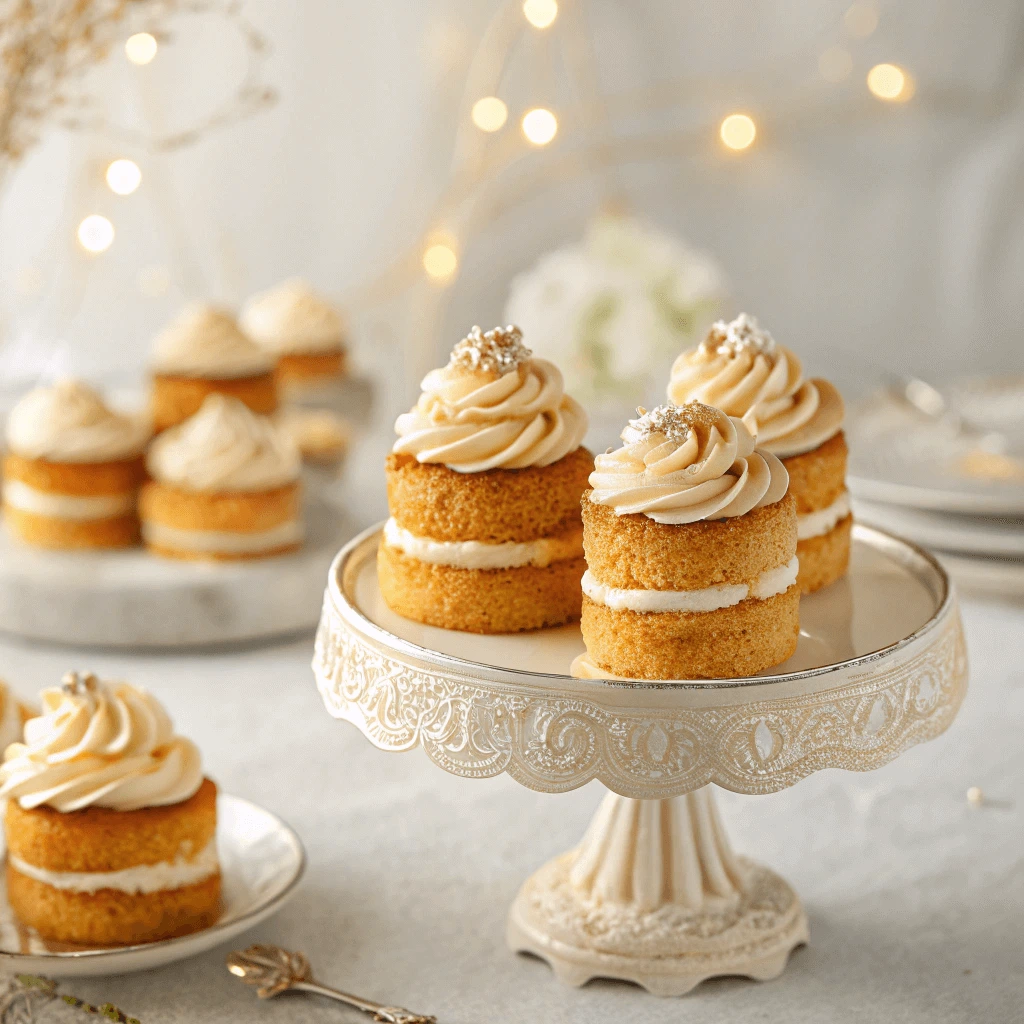If you’re searching for a fun and guilt-free dessert, this easy mini cakes recipe is perfect for you. These bite-sized treats are quick to prepare, made with wholesome ingredients, and customizable for any occasion. Whether you’re following a specific diet or just looking for a healthier way to enjoy sweets, mini cakes are a great option. With endless flavor variations and creative toppings, you can make every batch unique. Try this easy mini cakes recipe today and enjoy delicious, portion-controlled desserts that everyone will love.
Why Mini Cakes Are a Perfect Choice for Healthy Desserts

Portion Control for Healthier Eating
Mini cakes are a great way to enjoy desserts without overindulging. Their smaller size allows for portion control, helping you avoid the temptation to eat large servings. With each mini cake being its own individual portion, you can enjoy a treat while keeping your calorie intake in check.
Benefits of Portion Control
Mini cakes help you enjoy a sweet treat without going overboard on sugar and calories. The pre-portioned size makes it easier to stick to a balanced diet, ensuring you satisfy your cravings without guilt.
Mindful Eating with Mini Cakes
Mini cakes encourage mindful eating, allowing you to savor each bite. By focusing on enjoying a smaller, flavorful treat, you can feel satisfied with less, which helps avoid overeating and promotes healthier eating habits.
Healthier Alternatives in Mini Cake Recipes
If you’re looking to enjoy mini cakes with a healthier twist, there are plenty of ingredient swaps that can make these treats both nutritious and delicious.
1. Flour Alternatives
Instead of all-purpose flour, use whole wheat flour or almond flour. These options add fiber, protein, and healthy fats, making your mini cakes more filling and nutritious. Whole wheat flour also has a richer flavor, enhancing the overall taste.
2. Sugar Substitutes
Cutting down on sugar is easy with natural sweeteners like coconut sugar, stevia, or honey. Coconut sugar is a popular choice because it has a lower glycemic index, making it a better option for those looking to reduce blood sugar spikes. You can also use mashed fruits, like bananas or applesauce, to add natural sweetness and moisture.
3. Healthy Fats
Replacing butter with healthier fats can improve the nutritional profile of your mini cakes. Consider using Greek yogurt, coconut oil, or avocado. These fats offer heart-healthy benefits, with added protein and fewer empty calories. Avocado, for example, gives a creamy texture while adding healthy monounsaturated fats.
these healthier alternatives, your mini cakes can be both a satisfying treat and a better choice for your health, without sacrificing taste or texture.
Ideal for Various Diets
Mini cakes are a versatile dessert that can be easily adapted for different dietary needs. Whether you’re following a gluten-free, vegan, or low-carb diet, these bite-sized treats can be customized to suit any lifestyle without sacrificing taste.
1. Gluten-Free Options
For those who avoid gluten, mini cakes can be made with almond flour, coconut flour, or rice flour. These alternatives provide different textures and flavors, making them perfect for a gluten-free diet.
2. Vegan Mini Cakes
Vegan mini cakes replace eggs and dairy with plant-based alternatives. Flax eggs and almond milk make for a delicious, plant-based dessert without compromising on texture or taste.
3. Low-Carb and Keto-Friendly Choices
Mini cakes can easily fit into a low-carb or keto diet. By swapping out regular flour with almond flour and using low-carb sweeteners like stevia, you can enjoy a satisfying treat while keeping carbs low.
These adjustments ensure mini cakes remain a sweet, enjoyable dessert for various dietary preferences.
Essential Ingredients for Easy and Healthy Mini Cakes

Basic Ingredients You’ll Need
To make the perfect mini cakes, you only need a few key ingredients. These basics help create a light, fluffy, and flavorful dessert that’s sure to impress. Let’s go through each essential component that will make your mini cakes delicious and easy to prepare.
1. Flour: The Foundation of the Cake
Flour is the primary ingredient in any cake. It gives the mini cakes structure and texture. You can use all-purpose flour for a classic, soft cake base, or explore alternatives like whole wheat flour for a denser, nuttier flavor. For gluten-free options, almond flour, rice flour, or a pre-made gluten-free flour blend will work wonders without sacrificing taste or texture.
2. Sugar: Sweetness with Balance
Sugar is responsible for sweetening the mini cakes. You can use white sugar, brown sugar, or even coconut sugar for a touch of caramel-like sweetness. If you’re aiming for a healthier version, you can substitute traditional sugar with a sugar alternative like stevia, monk fruit sweetener, or even maple syrup. These alternatives will still give you a sweet result, but with fewer calories and a lower glycemic index.
3. Eggs: Binding and Moisture
Eggs play an important role in holding the ingredients together and adding moisture to the mini cakes. They also contribute to the cake’s rise and structure. If you’re looking for a vegan option, you can use substitutes like flax eggs (made by mixing ground flaxseed and water) or chia eggs to achieve a similar effect.
4. Baking Powder or Baking Soda: The Leavening Agents
Baking powder and baking soda are essential for making your mini cakes rise. They create bubbles in the batter, which give your cakes their light and fluffy texture. Be sure to use the right leavening agent according to your recipe, as they work differently. Baking powder is typically used in recipes that don’t contain acidic ingredients, while baking soda is best used when there are acidic elements like buttermilk or yogurt in the batter.
5. Butter or Oil: Richness and Moisture
Butter adds richness and a smooth texture to the batter. For a dairy-free or vegan option, you can substitute butter with oils like coconut oil, vegetable oil, or even applesauce for a healthier, lighter version. Using oil instead of butter can also yield a more moist mini cake that stays fresh longer.
These basic ingredients provide the foundation for any mini cake recipe. Once you have them on hand, you can easily customize your mini cakes with various flavors and mix-ins to create a personalized dessert that fits any occasion.
Flavor Variations and Add-Ins
Mini cakes provide endless flavor options to suit every taste. You can easily adapt the recipe by adding fruits, nuts, spices, and other fun ingredients. Here are some ways to mix things up:
1. Classic Vanilla and Chocolate
Vanilla and chocolate are timeless combinations. Add cocoa powder for a rich chocolate flavor or mix dark chocolate chunks into a vanilla base for a delicious twist.
2. Fruity Flavors
Add fresh fruits like berries, peaches, or bananas to the batter. Fruit purees like apple or pumpkin also make great additions, giving the cakes a moist texture and natural sweetness.
3. Nutty Additions
Incorporate chopped nuts like almonds, walnuts, or pecans for a crunchy texture. You can also swirl in nut butters for extra flavor and richness.
4. Spiced Delights
Spices like cinnamon, nutmeg, and ginger bring warmth and depth to the flavor. Try adding them for a cozy, comforting mini cake that’s perfect for cooler weather.
5. Creative Twists
For something unique, experiment with ingredients like lavender, matcha powder, or caramel. These creative touches will make your mini cakes stand out and impress your guests.
These variations help you create mini cakes that match any occasion or dietary need, offering a fun and flavorful way to enjoy bite-sized desserts!
Healthy Ingredient Substitutes
When making mini cakes, you can easily swap out certain ingredients for healthier alternatives. These changes can enhance the nutritional value without compromising flavor. Here are some smart swaps to consider:
1. Whole Wheat Flour for All-Purpose Flour
Using whole wheat flour instead of all-purpose flour boosts fiber content, which is beneficial for digestion. It also adds a subtle nutty flavor to your cakes.
2. Greek Yogurt for Butter or Sour Cream
Greek yogurt is a great substitute for butter or sour cream, providing creaminess and moisture with less fat and more protein.
3. Coconut Sugar for White Sugar
Coconut sugar is lower on the glycemic index and provides minerals like zinc and calcium. It offers a rich, caramel-like flavor that enhances your cakes.
4. Applesauce for Oil
Replacing oil with applesauce reduces the fat content of your cakes. Unsweetened applesauce also adds natural sweetness and moisture.
5. Almond Flour for Regular Flour
Almond flour is perfect for gluten-free cakes. It’s high in protein and healthy fats, offering a nutty flavor while keeping your mini cakes light and moist.
How to Make Easy Mini Cakes: Step-by-Step Instructions

Preparing the Mini Cake Pans
Properly preparing your mini cake pans is crucial to ensuring that your cakes come out easily and maintain their shape. Follow these steps for the best results.
1. Grease and Flour the Pans
Before adding any batter, coat the mini cake pans with a thin layer of butter, oil, or cooking spray. This prevents the cakes from sticking to the pan during baking. Once greased, lightly dust the pans with flour, tapping out any excess. Alternatively, you can use cocoa powder for chocolate cakes, which enhances the flavor and ensures an easy release. Some people even line the pans with parchment paper for extra security.
2. Use Nonstick Bakeware or Liners
If you have nonstick mini cake pans, they can reduce the need for greasing and flouring. However, if you want to be extra cautious or have concerns about sticking, consider using mini cake liners. These come in a variety of designs and help to make cleanup easier while also adding a decorative touch.
3. Ensure Even Coating
When preparing your mini cake pans, it’s important to cover every inch of the surface. Using a pastry brush can help you get an even coating of oil or butter on the pans, especially for more intricate mini cake designs. Make sure the edges and corners are well-greased so that your cakes won’t stick and tear when removed.
4. Preheat the Oven
Before placing your pans into the oven, make sure the oven is fully preheated to the correct temperature. This ensures that the cakes bake evenly and rise properly. Preheating helps the batter start cooking as soon as it hits the hot pans, resulting in a lighter and fluffier texture.
Mixing the Batter for Mini Cakes
Mixing the batter properly is essential for light and fluffy mini cakes. Here’s how to do it:
1. Prepare Your Ingredients
Ensure all ingredients are measured and ready before mixing. Separate your wet ingredients (butter, eggs, milk) and dry ingredients (flour, sugar, baking powder) for easier mixing.
2. Cream the Butter and Sugar
Start by creaming the butter and sugar until it becomes light and fluffy. This helps incorporate air into the batter for a lighter texture.
3. Add Wet Ingredients
Gradually add eggs, one at a time, and mix in milk and vanilla. For dairy-free options, substitute with non-dairy alternatives like almond milk.
4. Incorporate Dry Ingredients
Slowly mix in the dry ingredients, being careful not to over-mix, as this can make the cakes dense. Add any additional flavorings or spices as you mix.
5. Check Consistency
The batter should be smooth and thick, but pourable. If it’s too thick, add a splash of milk; if it’s too runny, add a bit more flour.
Following these simple steps will ensure your mini cakes come out perfectly every time.
Baking and Cooling Mini Cakes Perfectly
Baking and cooling mini cakes correctly is essential for achieving the perfect texture and flavor. Follow these steps to ensure your mini cakes come out soft, fluffy, and beautifully golden.
1. Preheat the Oven
Before placing the mini cakes in the oven, preheat it to the temperature indicated in the recipe, usually between 325°F and 350°F (163°C–177°C). Preheating ensures even baking from the start.
2. Properly Fill the Cake Pans
When filling the mini cake pans, aim to fill each one about 2/3 full to leave room for the cakes to rise without overflowing. Overfilling can cause the cakes to spill over, creating a mess in the oven.
3. Baking Time and Monitoring
Mini cakes bake faster than traditional-sized cakes, typically taking around 12-20 minutes, depending on the size of the pans and the oven. Start checking for doneness after 12 minutes by inserting a toothpick into the center of the cakes. If it comes out clean, they are done. If not, continue baking for a few more minutes.
4. Even Heat Distribution
Ensure the oven racks are centered so that the heat circulates evenly around the mini cakes. If your oven has hot spots, rotate the pans halfway through the baking time for uniform results.
5. Cooling the Mini Cakes
Once the cakes are done, remove them from the oven and allow them to cool in the pans for about 10 minutes. This will prevent them from sticking to the pans. After that, turn the pans upside down on a cooling rack to gently release the cakes. Allow them to cool completely on the rack to avoid any melting frosting or decorations.
6. Avoid Overbaking
Mini cakes can quickly turn dry if overbaked. Keep a close eye on the baking process and use the toothpick test to ensure they’re removed at the right moment.
Decorating Your Healthy Mini Cakes
Healthy Frosting Options
For healthier mini cakes, you can replace traditional frosting with nutrient-packed alternatives. These options are lower in sugar and fats while still offering creamy textures and rich flavors. Here are some healthy frosting ideas to consider.
1. Greek Yogurt Frosting
Greek yogurt creates a tangy, creamy frosting that’s lower in sugar. Simply mix plain Greek yogurt with a touch of honey or maple syrup for sweetness. This healthier option is perfect for fruity mini cakes or as a lighter alternative to buttercream.
2. Avocado Frosting
Avocados are rich in healthy fats and provide a smooth, creamy texture. Blend a ripe avocado with honey or coconut sugar to create a dairy-free, nutrient-rich frosting. It works wonderfully for chocolate or vanilla mini cakes.
3. Cashew Cream Frosting
Soak cashews and blend them with a bit of coconut milk to create a smooth, vegan-friendly frosting. Sweeten with maple syrup and add vanilla for extra flavor. This option is perfect for those seeking a gluten-free or dairy-free alternative.
4. Coconut Whipped Cream Frosting
For a light and fluffy option, use coconut milk to make whipped cream. Chill the can, whip the cream, and sweeten with powdered sugar or stevia. This is a great dairy-free frosting, perfect for tropical-themed mini cakes.
These healthier frosting alternatives offer a variety of textures and flavors to match your mini cakes, allowing you to enjoy a delicious treat with fewer calories and more nutritional benefits.
Creative and Healthy Toppings
Adding toppings to your mini cakes not only boosts their flavor but also makes them more visually appealing. Here are some healthy and creative topping ideas:
1. Fresh Berries
Fresh berries like strawberries, blueberries, and raspberries are a healthy and colorful option. They’re rich in antioxidants and add a sweet, tangy flavor to your cakes.
2. Nuts and Seeds
Chopped nuts (such as almonds or walnuts) and seeds (like chia or sunflower seeds) provide a satisfying crunch. They’re full of healthy fats and protein, making them a nutritious topping choice.
3. Coconut Flakes
Shredded coconut adds a tropical twist and is high in healthy fats and fiber. Choose unsweetened coconut for a low-sugar option.
4. Dark Chocolate
For a little indulgence, sprinkle dark chocolate shavings or cacao nibs on your mini cakes. Dark chocolate offers antioxidants and can balance the sweetness of the cake.
These toppings not only enhance the flavor but also add nutritional benefits, making your mini cakes both delicious and healthy!
Personalizing Mini Cakes for Any Occasion
Mini cakes shine when it comes to creativity. You can tailor their flavors, colors, and decorations to suit any event—from birthdays and baby showers to weddings and holidays. Here are a few easy ways to personalize your mini cakes:
Choose a Theme or Color Palette
Start by picking a theme based on the occasion. For a birthday party, go with vibrant colors and fun toppers like sprinkles or edible glitter. For elegant events like weddings or anniversaries, choose soft pastel tones or classic white frosting paired with gold accents.
Use Custom Molds or Toppers
Silicone molds in fun shapes—like hearts, stars, or flowers—instantly make your mini cakes feel special. You can also add custom toppers made of chocolate, fruit, or printed edible paper to reflect the event.
Incorporate Personalized Flavors
Infuse your cakes with unique flavors that match the event’s vibe. For example, try citrus zest for a summer party, cinnamon and nutmeg for holiday gatherings, or rosewater for a romantic celebration. Flavoring the frosting or filling adds another layer of personalization.
With just a few thoughtful changes, you can turn a basic mini cake recipe into a beautiful, custom dessert centerpiece that leaves a lasting impression.
Delicious Mini Cake Variations to Try
Mini Bundt Cakes
Mini Bundt cakes are a charming and elegant variation of mini cakes that combine classic shapes with individual serving sizes. Their distinct ridges and circular design not only make them visually appealing but also ideal for catching glazes, drizzles, and toppings.
Unique Presentation
These small cakes stand out due to their decorative shapes. You can find mini Bundt pans in a range of styles—from simple swirls to intricate floral patterns. Their built-in design eliminates the need for elaborate frosting, making them perfect for quick yet impressive desserts.
Flavorful and Moist
Mini Bundt cakes are known for their rich and moist texture. Because they’re slightly denser than cupcakes, they hold up well to bold flavors like chocolate, lemon, pumpkin, or spiced apple. You can also incorporate fillings such as fruit preserves or cream cheese for added surprise and depth.
Perfect for Any Gathering
These cakes work wonderfully for holidays, bridal showers, or afternoon tea. Their neat portion sizes reduce mess and make serving easy. You can bake multiple flavors in one batch and offer guests a variety to choose from. To add a healthier twist, try using whole wheat flour, natural sweeteners, or dairy-free glazes.
Mini Bundt cakes let you blend creativity and tradition in one petite package. With the right pan and a little imagination, you can bake desserts that look professional while keeping the process fun and manageable.
Cupcake-Style Mini Cakes
Cupcake-style mini cakes are one of the most accessible and versatile ways to enjoy bite-sized desserts. Unlike traditional cupcakes, which often follow standard recipes, these mini cakes allow for more creativity in flavor, texture, and presentation—while still using a familiar cupcake pan.
Simple and Convenient
Cupcake-style mini cakes are incredibly easy to prepare. All you need is a standard muffin or cupcake tin and your favorite cake batter. Line each cavity with cupcake liners for easy removal and minimal cleanup. These small cakes bake evenly and quickly, making them ideal for busy home bakers who want a sweet treat without much hassle.
Customizable for Every Occasion
These mini cakes are perfect for birthdays, showers, holidays, or just a fun family baking activity. You can decorate each one differently to suit your theme or guest preferences. Use natural food colors, edible decorations, or even handwritten messages with icing for a personalized touch.
Healthier Versions Available
You can easily adapt cupcake-style mini cakes to meet dietary needs. Replace white flour with almond or oat flour, use unsweetened applesauce instead of oil, and choose a low-sugar frosting to reduce calories. These adjustments maintain the cake’s deliciousness while offering better nutrition.
Cupcake-style mini cakes combine the ease of cupcakes with the elegance of mini desserts. They give you the freedom to experiment while keeping the portions controlled and the presentation fun.
Healthy Variations (Gluten-Free, Vegan, etc.)
Mini cakes can easily be adapted to fit a variety of dietary needs without sacrificing flavor or texture. Whether you’re baking for someone with food allergies or just looking to eat cleaner, there are many healthy variations that turn traditional recipes into nourishing treats.
Gluten-Free Mini Cakes
For those avoiding gluten, using gluten-free flour blends is an easy switch. Almond flour, oat flour, or a gluten-free all-purpose mix works well in mini cake recipes. These flours maintain a moist crumb and can even add a slight nutty flavor. Just remember to check your baking powder and other ingredients to ensure they’re certified gluten-free.
Vegan Mini Cakes
You can make your mini cakes vegan-friendly by replacing eggs and dairy. Mashed bananas, applesauce, or flaxseed meal mixed with water are great egg substitutes. Use plant-based milk (like almond or oat milk) and vegan butter or coconut oil instead of dairy. These swaps still yield a rich and satisfying dessert that everyone can enjoy.
Low-Sugar and Dairy-Free Options
To reduce sugar, try using natural sweeteners like maple syrup, dates, or coconut sugar. These options provide sweetness without refined sugar and come with added nutrients. If you’re going dairy-free, use alternatives like almond yogurt or coconut cream to keep the mini cakes soft and flavorful.
Healthy variations allow more people to enjoy mini cakes while still aligning with their dietary choices. With a few simple ingredient swaps, you can serve delicious desserts that meet different needs—all without compromising taste or presentation.
Conclusion
Mini cakes are a delightful and versatile dessert option that offer portion control, customizable ingredients, and the ability to suit a range of diets, from gluten-free to vegan. Their smaller size makes them ideal for healthy indulgence without the guilt. With endless possibilities for flavors, frostings, and toppings, these bite-sized treats can be tailored to any occasion or personal preference. Don’t be afraid to get creative—experiment with different variations and decorations to find your favorite combinations. With mini cakes, healthy and delicious truly go hand in hand.
